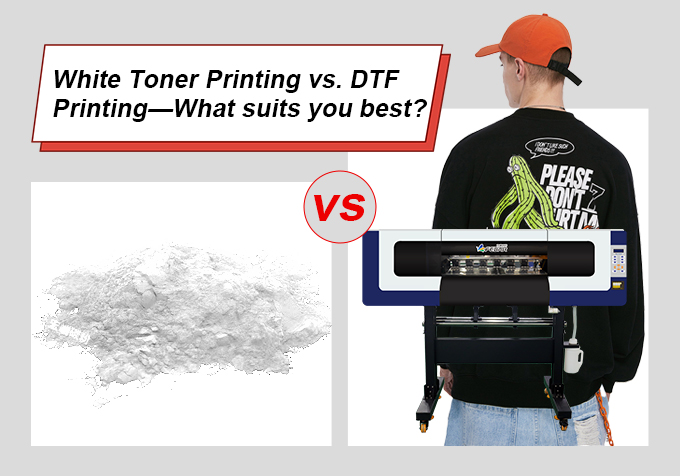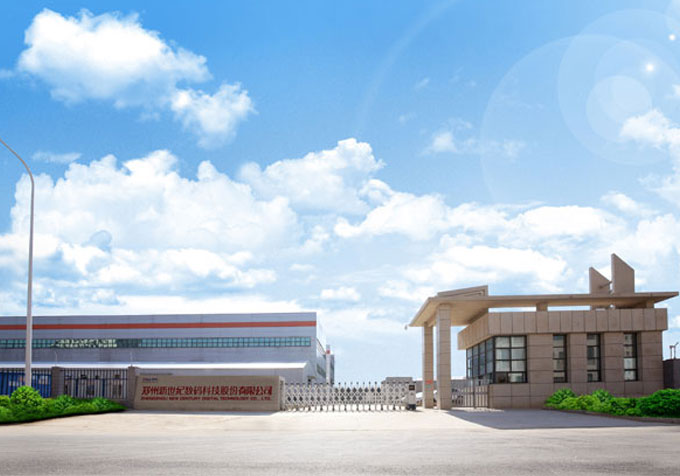14
Sep

The universe of digital printing is consistently expanding. Business owners and hobbyists alike are lucky to have many printer options to choose from these days. But you must equip and upgrade yourself with the right comparative information to make the right printer choice.
We will discuss two popular printing methods: direct-to-film and white-toner printing. Keep on reading to learn the similarities and differences between the two and the pros and cons they offer.
DTF printers print the designs on a plastic film in the first step. Then, the printed film is placed on the desired surface, and a heat press transfers the prints onto the substrate. DTF printing involves water-based liquid inks and employs inkjet technology.
White-toner printing involves the use of laser printers and CMYK toner cartridges instead of water-based ink for printing. Like in DTF printing, the first print goes on the special PET plastic film. In the second step, the print is transferred from the film to a substrate using a heat press.
DTF printers and white-toner printers look nothing like each other; they seem like two completely different machines. But in reality, they share quite a few similarities between them:
DTF and the White Toner printers use a polyethylene terephthalate (PET) film to print on before the designs are printed on the garments.
Both printers use white color as a base.
The films used in both printers contain an adhesive film for effective print transfer.
Both methods produce detailed, vibrant, and high-resolution prints.
A heat press is essential for both DTF and white-toner printing.
The cold-peel method can be used for both printing types.
Now that we have learned the similarities between the two printing techniques, let’s explore how they differ. We’ll go through all their differences one by one:
A DTF printer requires RIP software to manage the pictures and the special ink. Although developments have been made in RIP, learning to use it properly might become a problem. On the other hand, people can easily navigate the software used for white-toner printers because it is mature now.
DTF printing uses inkjet printers and water-based inks, whereas white-toner printing uses laser printers and CMYK toner cartridges.
DTF prints are usually more lasting because these printers use special textile inks designed to withstand wear and tear. White-toner printing patterns may not stand the test of time because they have poor resistance to washing. So when printing on textiles, DTF printers are a better choice because the garments go through multiple washes.
When we talk about maintenance, white-toner printers are a winner because they require minimal maintenance. DTF printers require regular and proper maintenance for long-term use. Proper maintenance is not only necessary, but it prolongs the life of your DTF printer.
White-toner printers have a broader scope of applications as they can print on multiple surfaces, so they are used for making banners, badges, signs, magnets, and much more. DTF printers mainly focus on the textile industry.
DTF printing produces soft and even prints, whereas white-toner printing produces thicker, grainy prints. DTF prints have the advantage of stretchability over white-toner prints.
DTF printers offer a lower entry cost than white-toner printers. However, if you want something more reliable and maintenance-free, choose white-toner printers.
DTF and white toner, both methods of printing, offer their own sets of benefits and drawbacks. Getting an in-depth understanding of these methods will help you choose the method that best suits your needs and requirements.
Let us discuss DTF printing first:
Any color or fabric can be printed through DTF.
DTF offers great durability and resistance to fading or breaking. It produces anti-stretch prints.
It is cost-effective and flexible.
The results are high-resolution, detailed, vibrant, and smooth to the touch.
DTF printers require more complicated maintenance than white-toner printers.
The uses of DTF are limited to textiles.
The pros and cons of white-toner printing are listed below:
White-toner printers require little to no regular maintenance.
They can print on a wide range of substrate materials.
The laser printing method offers faster speeds.
White-toner printers cost more than DTF, and their consumable costs are higher.
The prints are not as durable for long-term use.
If analyzed objectively, both DTF printing and white-toner printing offer their own unique set of advantages and disadvantages. The factors that should influence your choice the most are your needs and vision.
If you're aiming to make your mark in the garment printing industry or you want to grow your garment business, DTF printing would be a no-brainer choice. It doesn’t limit your choice of fabric or color, ensuring high-quality, anti-stretch, and fade-resistant prints. DTF printing also minimizes downtime by offering flexibility. These qualities make it a more feasible solution for growing businesses.
On the other hand, white-toner printing takes the lead in versatility and ease. White-toner printers allow you to print on a variety of substrate materials, like fabrics, paper, and hard surfaces, without pre-treatment. Thus, white-toner printers are perfect if you have versatile printing needs. Consistent learning can help you grow as a business because if you have the right knowledge, you will always make the right choices.
If there's anything we can do to further showcase machines' features, please let us know.
Email: sale@fedar.net
Whatsapp: +86 15515715397
Our company has over 30 models of printers with independent intellectual property rights and patents. Marketed under the esteemed brands of Skycolor, Stormjet, and Fedar brands, these printers cover a wide range, including digital textile printers, UV printers, eco-solvent printers and more. Known for their exceptional quality and performance.
